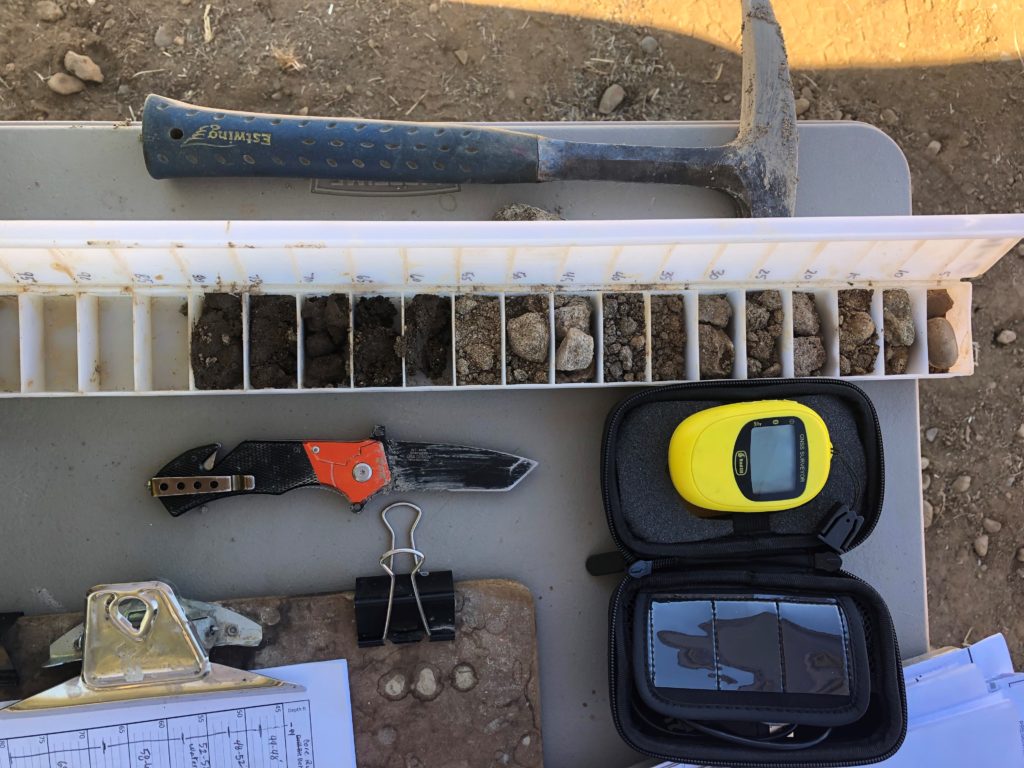Subsurface site conditions are complex. When it comes to environmental remediation, understanding the hydrogeologic conditions is critical in achieving effective remediation and regulatory compliance. In this blog, Principal Hydrogeologist Dr. Leo Leonhart explains how heterogeneity impacts site characterization and remedy design.
What is Heterogeneity?
We celebrate diversity in such contexts as cultural diversity, species diversity, investment diversity, and even diet diversity. And usually, diversity is deemed a desirable goal or condition. In hydrogeology, we might think of diversity as heterogeneity. Heterogeneity essentially refers to textural differences in an aquifer, and hence, in the way aquifer materials transmit water. In turn, such differences control the movement of contaminants. In granular porous media, which comprise the materials of most aquifers, this control results from the dominant size of grains (i.e., gravel, sand, silt, clay).
It seems intuitive that groundwater movement through coarser materials would be easier and faster than movement through finer materials. But consider a material where grain size is nonuniform, but instead a mixture of different sizes. Or on a broader scale, there may be zones of finer materials interspersed among a domain of coarser materials. What then would be the pathway of groundwater and any dissolved contamination through the aquifer? And from the standpoint of designing a remedy, what needs to be done to capture or at least contain a contaminant plume? Moreover, in consideration of such complexities, how long will it take to reduce contamination to achieve remedial action objectives (RAOs)?
Heterogeneity and Your Conceptual Site Model
While the various analytical tools that were first used to characterize groundwater flow were based on simplifying assumptions, such as homogeneity (which is the opposite of heterogeneity), often, the situations we face do not adhere to such assumptions. Natural environments are more typically heterogeneous, thereby complicating the remedial design problem and often extending timeframes to achieve RAOs.
So, let’s just say that it really helps to understand the nature of the geologic system under consideration … the nature of the materials comprising the aquifer. This understanding is embraced by the technical term, conceptual site model (CSM), which accounts for the overall characteristics of the hydrogeologic system as well as the nature and history of contamination and the vulnerable receptors. Let’s look at three examples of how heterogeneity manifests site complexities.
Groundwater Pathways and Migration of Contaminant
Consider for example, an alluvial system, which is often a complex assemblage of sedimentary features such as channel deposits, deltas, overbank deposits, fans, and terraces developed during the depositional history of the stream (Figure 1). Note that within such a depositional assemblage, a wide array of features and grain sizes develop. In turn, this creates complex conditions that affect groundwater movement, often creating intricate pathways for contaminant movement. Note how preferential pathways result from contrasting grain sizes in the example shown below (Figure 1). Groundwater and dissolved contaminants will preferentially flow in the coarse-grained channel deposits.

Figure 1. Conceptualized development of alluvial deposition illustrating the formation of heterogeneities. (n.d). Geology Department, West Virginia University. Retrieved 2019 from http://www.geo.wvu.edu/~kammer/g3%5CFacies.pdf
Diffusive Movement of Contaminants
Another consideration regarding heterogeneity is how, over time, contaminants may diffuse into the finer grained materials. In turn, having entered these “tighter” materials, they are slow to diffuse out even when concentration gradients are favorable due to advective movement of contaminants along the adjacent coarser materials. Consider Figure 2, which shows advective movement through the coarse-grained region of the aquifer depicted by blue arrows. Diffusive movement of contaminants exiting finer-grained lenses is depicted by the red arrows, which is a slower process.
Each of these alluvial features may be characterized by a wide range of grain sizes or even by a particular progression of grain sizes. As groundwater and dissolved contaminants move through such a system, pathways may be rather circuitous. In recent years, movement along such pathways has been studied in the field and using numerical model simulations. One particle tracking study of a heterogeneous aquifer revealed that the fastest 5% of the particles converge on preferential flow paths and accounted for about 40% of the flow. Moreover, these preferential flow paths were influenced by interconnected clusters of high hydraulic conductivity materials (Bianchi, M. et al., 2011). Basically, heterogeneity has a considerable influence on channeling patterns and interconnectivity in aquifers (Fiori and Jankovic, 2012).
Another complexity of heterogeneous systems is that contaminants can “take up residence” in finer-grained materials, while another fraction of the contaminant plume may travel more freely downgradient (Figures 2 & 3). For such reasons, extraction of contaminated groundwater by a pump-and-treat (P&T) remedy becomes more difficult and increases the cleanup time.

Figure 2. Conceptualized aquifer system with lenses of finer-grained materials showing slow diffusion of contaminants from lenses (red arrows) into advective region of aquifer (blue arrows).

Figure 3. Comparison of migration pathways developed within porous media with different degrees and types of heterogeneity (after Freeze and Cherry, 1979).
Plume Heterogeneity
One other, generally less considered, aspect of heterogeneity that can complicate remedial design is plume heterogeneity. Often, we like to think of a contaminant plume as being a continuous progression of the contaminant moving away from a source, with the highest concentrations close to the source and decreasing progressively with downgradient distance away from the source. Again however, reality is seldom this ideal. Contaminant source areas change through time.
One site studied by Hargis has had an operating history of 100 years. Such plume complexity can result from the contaminant history at the site. Regarding the 100-year-old site, the types of manufactured products, processes, locations of processing, locations of disposal, waste treatment, etc. all changed through the years. These changes were compounded with the natural dynamics of the hydrogeologic environment such as precipitation, streamflow, evapotranspiration variability. Collectively, such factors contributed to uneven distribution or “spotty” distribution in the occurrence of contaminants in the aquifer. As illustrated in Figure 4, such information not only can result from different activities at the same site, but also can occur when there are multiple releases from the different facilities. Therefore, that information could be important in allocating responsibility among multiple parties.
Click here to learn more about this case study.

Figure 4. Conceptual comparison of areal plume development with time under various source release scenarios.
Finally, it is easy to understand that the heterogeneities that make contaminant extraction complex likewise serve to complicate remedial actions. Consider that, if heterogeneity results in extending timeframes for P&T, similarly it would be likely that the timeframe for an in situ remedy would be extended because of the difficulty in delivering the essential reagents (Payne, F.C., et al., 2008).
What’s the takeaway?
Site characterization and remedial design can’t always be generalized for reasons related to heterogeneity. Furthermore, it may not be enough to sufficiently characterize your site. The next step is convincing regulatory agencies you’ve accurately characterized site conditions and your remedial design accounts for the specific site complexities.
If you’re frustrated with navigating the regulatory framework, we are here to help. Hargis is recognized and respected by local, state, and federal regulatory agencies. Our consultants have extensive experience with potentially responsible parties (PRPs) and a wide range of stakeholder groups. With Hargis, you have direct access to environmental experts in hydrogeology and remediation engineering ready to support your site characterization and remediation needs from science to compliance.

About the Author
Dr. Leo Leonhart, PhD, RG, CHG
Principal Hydrogeologist/ Senior Technical Director
Hargis + Associates, Inc.
lleonhart@hargis.com
Dr. Leo Leonhart has professional experience in geology, hydrogeology, and environmental science since 1974. His technical experience includes individual contributions and management roles in government, industry, and academia, and in operations and technical management in environmental consulting. His technical work experience is diverse including hydrogeologic investigations, watershed studies, and environmental assessments. He has managed technical teams of scientists and engineers and engaged in university teaching research as well as management of work by technical subcontractors and consultants. Additionally, he has consulted with various Native American Tribes providing technical workshops and recommendations for addressing cultural and environmental issues.
References
Bianchi, M., C. Zheng, C. Wilson, G.R. Tick, G. Liu, S. M. Goerlick (2011). Spatial connectivity in a highly heterogeneous aquifer: from cores to preferential flow paths. Water Resources Research. Vol. 47, W05524.
Fiori, A. and I. Jankovic (2012). On preferential flow, channeling and connectivity in heterogeneous porous formations. Mathematical Geosciences. Vol. 44, p.133-145.
Freeze, R.A. and J.A. Cherry (1979) Groundwater, Prentice Hall.
Payne, F.C., J.A. Quinnan II, S.T. Potter III (2008) Remediation Hydraulics. CRC Press.

